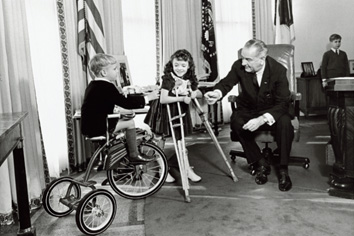Happy birthday, Medicaid!
The program that President Lyndon B. Johnson signed into law has lasted 50 years. Medicaid has become part of the fabric of American life, medical safety net that serves the Americans who are least likely to get health care coverage from any other source.
A long list of laws have adjusted Medicaid in ways that form consistent trends, experts say. The most recent additions—currently in their comments period—may offer clues to where the program is headed next.
“In terms of the overall program structure, there are two interesting points. One has to do with a series of steps involving expansion of coverage for children, which took place over a period of years and ultimately provided a source of coverage for all children under the federal poverty limit,” says Penny Thompson, who left her post as deputy director for the Center for Medicaid and Shift Services in Baltimore in September 2014 and is now a consultant in Elliott City, Maryland.
“That's made a big difference for low-income families,” Thompson continues. “Positive research shows that children in enrolled families are successfully accessing care, especially primary care, though there are pockets of concern—a lack of coverage for dental care, delays in getting appointments, problems accessing specialists—and a lot of local variation.”
In a similar way, Thompson says, Medicaid has incrementally added services for people with disabilities, including home-based options for delivering services.
“In part because of strong and effective advocacy from the disability community, Medicaid has given people with disabilities options in supporting them outside institutions,” she says, adding that today, individuals receiving care are as apt to be getting home care as institutional care. “Dollars are split about 50/50.”
Thompson thinks that program expansion will continue, and that all U.S. states will eventually participate in that expansion, despite the political upheaval that currently surrounds it.
Caroline Pearson, senior vice president at Avalere Health in Washington, D.C., agrees.
“I think there will be full adoption, but it may take a decade to have the vast majority of states on board,” she says. “At the moment, there is so much anti-ACA and anti-Obama sentiment, and that is dominating the decision-making. The further you get away from the passage of the ACA, the more the politics will quiet down.”
Economics, she adds, will prevail. “The fact is that there is a huge amount of federal money on the table to both insure citizens and grow the states' health care economies,” Pearson says.
Even the states that are currently not participating in the full Medicaid expansion are finding ways to use federal money to pay for health care, Thompson says.
“Virtually every state, including those that have thus far rejected expansion, are engaged in productive and meaningful steps to promote quality, affect health care costs overall and deliver coordinated care,” she notes.
Even as Medicaid expansion takes root, however, states are looking for ways to shift costs away from their own checkbooks. Many states that have thus far rejected Medicaid expansion as a whole are using program waivers, essentially implementing customizable approaches to expansion.
“Medicaid has broad waiver authority to allow any sort of experimental programs in the states where it's happening, and most of the states that have joined in the last six to 12 months have used waivers. They're using the premium assistance model to enroll the expansion population into exchange plans and use the extra money to subsidize that,” Pearson says. Montana, too, is working on expanding and is in negotiations with the Center for Medicare and Medicaid Services for a waiver that would give the state more cost-sharing flexibility.
Even the states that have fully accepted Medicaid expansion are customizing their approaches to shift some costs onto beneficiaries.
“We've seen a flurry of waiver requests that would allow for charging people premiums, incentivize healthy behaviors, put in work requirements, or put in health savings accounts. That's a change from the status quo,” says John Holahan, an institute fellow specializing in health care economics at the Urban Institute in Washington, D.C.
Because Medicaid expansion gives beneficiaries higher income limits, some recipients may be able to afford deductibles or copays, an expense that states are happy to let them shoulder.
“As Medicaid expands and covers slightly higher-income adults, those people look like they could contribute more financially and maybe don't need a full menu of services,” Pearson says. “Medicaid used to be mostly for kids and disabled adults, and we didn't expect them to do much for themselves. It was incredibly generous and mostly free. As you start to fill the program with people who have more independent means, there will be a lot of questions. As we move toward universal coverage, how do you create a fair sliding scale in terms of cost assistance and scope of benefits?”
Many states also see managed care for Medicaid recipients as another cost-cutting measure, a trend that will probably continue.
“States are moving out of the business of trying to run a health care program; they will rely on private plans to do that,” Pearson says. “Everything about how the rest of us get our health insurance and deal with health plans will start to apply in Medicaid.” But there is currently little federal oversight for managed care Medicaid, a deficit Pearson thinks will eventually change by adding more beneficiary protections into Medicaid rules.
Managed care may also make it easier for Medicaid recipients to move from government benefits to the insurance marketplace as their economic situations improve.
“It's good for recipients to have available, both in the marketplace and via Medicaid,” Thompson says. “Now that we have the ACA subsidizing policies, you might have a family where the kids are covered under Medicaid and the parents are covered under an exchange plan, or a family is covered under Medicaid today and their income increases so they move to the same plan in the marketplace. As incomes change, people may not have to disrupt the delivery of care for people who are sick.” That consistency of care is important, she adds.
As states change the face of Medicaid, though, it's important that they don't lose sight of the program's original intent, Thompson says.
“On the one hand, in a lot of respects, Medicaid is a payer like other payers, and it covers a lot of people who might otherwise be covered by individual or employer plans,” she says. “On the other hand, Medicaid covers people with lower incomes, disabilities and long-term care, so less cost sharing is possible. Some states want to have more of a focus on cost sharing, because they think it's useful for people to get used to paying something. That way they understand that there are out-of-pocket expenses when they move to another payer. They still need to be extremely sensitive to the fact that any copay for people in poverty can prevent them from getting the care that they need.”
By the same token, it's important that states not drop benefits that are important to the poorest benefit recipients. “Non-emergency transportation is something you won't find in a regular plan, but it can be very significant to a low-income person in helping access care,” Thompson adds.
Despite all these changes, Medicaid probably isn't going away, at least not any time soon. “Unless Republicans take over the presidency and both houses of Congress, I don't think the basic structure will change,” Holahan says. “Sixteen million people get coverage through Medicaid, and it would be very difficult to replace.”
Medicaid through the years
As with any law—especially one with a long reach and a life of at least 50 years—a patchwork of changes has adjusted Medicaid this way and that. Overall, the changes have expanded the list of people who are eligible for Medicaid and given them a broader array of care options.
'60s & '70s

United States President Lyndon Johnson talking with two disabled children at the White House. Washington, 1960s. Mondadori/Newscom.
July 30, 1965: The Social Security Amendments of 1965 establishes Medicare and Medicaid to cover health care for poor children, caretakers, the elderly, the blind, and people with disabilities.
January 23, 1967: Children receiving Medicaid get mandated early and periodic screening, diagnosis and treatment services.
October 30, 1972: The Supplemental Security Income (SSI) program of cash assistance for the elderly and people with disabilities begins.
'80s
January 1, 1982:
Arizona becomes the last state to start participating in Medicaid.
September 3, 1982:
States get expanded ability to impose nominal cost-sharing on some Medicaid beneficiaries and services, and can extend Medicaid coverage to those who are under age 18 with disabilities that require institutional care, but are living at home.

July 18, 1984:
Medicaid coverage is extended to children born after Sept. 30, 1983, in families eligible for Aid to Families with Dependent Children, as well as AFDC-eligible first-time pregnant women and pregnant women in two-parent unemployed families.
April 7, 1986:
Medicaid covers all remaining AFDC-eligible pregnant women.
December 22, 1987:
States can extend coverage to pregnant women and infants with family income at or below 185 percent of the federal poverty level.
July 1, 1988:
States must use Medicaid funds to pay the Medicare premiums and cost sharing for low-income Medicaid beneficiaries with incomes below the federal poverty level.
'90s
Complete your profile to continue reading and get FREE access to BenefitsPRO, part of your ALM digital membership.
Your access to unlimited BenefitsPRO content isn’t changing.
Once you are an ALM digital member, you’ll receive:
- Critical BenefitsPRO information including cutting edge post-reform success strategies, access to educational webcasts and videos, resources from industry leaders, and informative Newsletters.
- Exclusive discounts on ALM, BenefitsPRO magazine and BenefitsPRO.com events
- Access to other award-winning ALM websites including ThinkAdvisor.com and Law.com
Already have an account? Sign In
© 2024 ALM Global, LLC, All Rights Reserved. Request academic re-use from www.copyright.com. All other uses, submit a request to [email protected]. For more information visit Asset & Logo Licensing.








